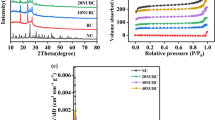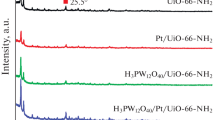Abstract
The porous and water-stable polyoxometalates-based Zr-MOFs PW12@UiO-NH2 was proposed for photocatalytic H2 evolution and degradation pollutants via adopting Keggin-type polyoxometalates (POMs) into UiO-66-NH2 through a facile one-step solvothermal method. Systematically characterizations were carried out to confirm the encapsulation of Keggin-type PW12 within the cavities of porous UiO-66-NH2 without modifying its fundamental framework. Benifiting from the integration of Keggin-type PW12 units with redox activity and porous UiO-66-NH2, the results showed that enhanced photocatalytic H2 evolution performance and RhB degradation activity for PW12@UiO-NH2 were realized compared with pristine UiO-66-NH2 under visible-light irradiation. The significant improvement of photocurrent density under a monochromatic light irradiation implied the faciliated separation procedure of photo-generated charge carriers with the incorporation of Keggin-type PW12 units. Hence, our findings reveal a novel topology POM-based MOFs which paves a way for environmental and energy applications.














Similar content being viewed by others
References
Fujishima A, Honda K (1972) Electrochemical photocatalysis of water at semiconductor electrode. Nature 238:37–38
Li Y, Hou Y, Fu Q, Peng S, Hu YH (2017) Oriented growth of ZnIn2S4/In(OH)3 heterojunction by a facile hydrothermal transformation for efficient photocatalytic H2 production. Appl Catal B 206:726–733. https://doi.org/10.1016/j.apcatb.2017.01.062
Xu C-Q, Xiao Y-H, Yu Y-X, Zhang W-D (2018) The role of hydrogen bonding on enhancement of photocatalytic activity of the acidified graphitic carbon nitride for hydrogen evolution. J Mater Sci 53(1):409–422. https://doi.org/10.1007/s10853-017-1507-6
Mohaghegh N, Kamrani S, Tasviri M, Elahifard M, Gholami M (2015) Nanoporous Ag2O photocatalysts based on copper terephthalate metal–organic frameworks. J Mater Sci 50(13):4536–4546. https://doi.org/10.1002/ange.201800269
Liang Z, Qu C, Xia D, Zou R, Xu Q (2018) Atomically dispersed metal sites in MOF-based materials for electrocatalytic and photocatalytic energy conversion. Angew Chem Int Ed Engl. https://doi.org/10.1002/anie.201800269
Dolgopolova EA, Rice AM, Martin CR, Shustova NB (2018) Photochemistry and photophysics of MOFs: steps towards MOF-based sensing enhancements. Chem Soc Rev. https://doi.org/10.1039/C7CS00861A
Usman M, Mendiratta S, Lu K-L (2017) Semiconductor metal–organic frameworks: future low-bandgap materials. Adv Mater 29(6):1605071. https://doi.org/10.1002/adma.201605071
Li S, Sun S, Wu H, Wei C, Hu Y (2018) Effects of electron-donating groups on the photocatalytic reaction of MOFs. Catal Sci Technol 8(6):1696–1703. https://doi.org/10.1039/C7CY02622F
Lan G, Zhu Y-Y, Veroneau SS, Xu Z, Micheroni D, Lin W (2018) Electron injection from photoexcited metal-organic framework ligands to Ru2 secondary building units for visible-light-driven hydrogen evolution. J Am Chem Soc 140(16):5326–5329. https://doi.org/10.1021/jacs.8b01601
Cavka JH, Jakobsen S, Olsbye U, Guillou N, Lamberti C, Bordiga S, Lillerud KP (2008) A new zirconium inorganic building brick forming metal organic frameworks with exceptional stability. J Am Chem Soc 130(42):13850–13851
Gomes Silva C, Luz I, Llabres i Xamena FX, Corma A, Garcia H (2010) Water stable Zr-benzenedicarboxylate metal-organic frameworks as photocatalysts for hydrogen generation. Chemistry 16(36):11133–11138. https://doi.org/10.1002/chem.200903526
Lin R, Shen L, Ren Z, Wu W, Tan Y, Fu H, Zhang J, Wu L (2014) Enhanced photocatalytic hydrogen production activity via dual modification of MOF and reduced graphene oxide on CdS. Chem Commun 50(62):8533–8535. https://doi.org/10.1039/c4cc01776e
Zhou J-J, Wang R, Liu X-L, Peng F-M, Li C-H, Teng F, Yuan Y-P (2015) In situ growth of CdS nanoparticles on UiO-66 metal-organic framework octahedrons for enhanced photocatalytic hydrogen production under visible light irradiation. Appl Surf Sci 346:278–283. https://doi.org/10.1016/j.apsusc.2015.03.210
Wang R, Gu L, Zhou J, Liu X, Teng F, Li C, Shen Y, Yuan Y (2015) Quasi-polymeric metal-organic framework UiO-66/g-C3N4 heterojunctions for enhanced photocatalytic hydrogen evolution under visible light irradiation. Adv Mater Interfaces 2(10):1500037. https://doi.org/10.1002/admi.201500037
Yang J, Dai Y, Zhu X, Wang Z, Li Y, Zhuang Q, Shi J, Gu J (2015) Metal–organic frameworks with inherent recognition sites for selective phosphate sensing through their coordination-induced fluorescence enhancement effect. J Mater Chem A 3(14):7445–7452. https://doi.org/10.1039/c5ta00077g
Su Y, Zhang Z, Liu H, Wang Y (2017) Cd0.2Zn0.8S@UiO-66-NH2 nanocomposites as efficient and stable visible-light-driven photocatalyst for H2 evolution and CO2 reduction. Appl Catal B 200:448–457. https://doi.org/10.1016/j.apcatb.2016.07.032
Wang SS, Yang GY (2015) Recent advances in polyoxometalate-catalyzed reactions. Chem Rev 115(11):4893–4962. https://doi.org/10.1021/cr500390v
Zhao X, Zhang S, Yan J, Li L, Wu G, Shi W, Yang G, Guan N, Cheng P (2018) Polyoxometalate-based metal-organic frameworks as visible-light-induced photocatalysts. Inorg Chem. https://doi.org/10.1021/acs.inorgchem.8b00098
Ye JJ, Wu CD (2016) Immobilization of polyoxometalates in crystalline solids for highly efficient heterogeneous catalysis. Dalton Trans 45(25):10101–10112. https://doi.org/10.1039/c6dt01378c
Bigi F, Corradini A, Quarantelli C, Sartori G (2007) Silica-bound decatungstates as heterogeneous catalysts for H2O2 activation in selective sulfide oxidation. J Catal 250(2):222–230. https://doi.org/10.1016/j.jcat.2007.06.019
Ruiz V, Suárez-Guevara J, Gomez-Romero P (2012) Hybrid electrodes based on polyoxometalate–carbon materials for electrochemical supercapacitors. Electrochem Commun 24:35–38. https://doi.org/10.1016/j.elecom.2012.08.003
Vilà-Nadal L, Cronin L (2017) Design and synthesis of polyoxometalate-framework materials from cluster precursors. Nat Rev Mater 2:17054. https://doi.org/10.1038/natrevmats.2017.54
Zhang Y, Lin B, Sun Y, Han P, Wang J, Ding X, Zhang X, Yang H (2016) MoO2 @Cu@C composites prepared by using polyoxometalates@metal-organic frameworks as template for all-solid-state flexible supercapacitor. Electrochim Acta 188:490–498. https://doi.org/10.1016/j.electacta.2015.12.037
Zhang Z-M, Zhang T, Wang C, Lin Z, Long L-S, Lin W (2015) Photosensitizing metal–organic framework enabling visible-light-driven proton reduction by a Wells–Dawson-type polyoxometalate. J Am Chem Soc 137(9):3197–3200
Kong XJ, Lin Z, Zhang ZM, Zhang T, Lin W (2016) Hierarchical integration of photosensitizing metal-organic frameworks and nickel-containing polyoxometalates for efficient visible-light-driven hydrogen evolution. Angew Chem Int Ed 55(22):6411–6416
Katz MJ, Brown ZJ, Colon YJ, Siu PW, Scheidt KA, Snurr RQ, Hupp JT, Farha OK (2013) A facile synthesis of UiO-66, UiO-67 and their derivatives. Chem Commun 49(82):9449–9451. https://doi.org/10.1039/c3cc46105j
Liu X, Li Y, Peng S, Lu G, Li S (2013) Photosensitization of SiW11O8-39-modified TiO2 by Eosin Y for stable visible-light H2 generation. Int J Hydrog Energy 38(27):11709–11719. https://doi.org/10.1016/j.ijhydene.2013.06.095
Damyanova S, Dimitrov L, Mariscal R, Fierro J, Petrov L, Sobrados I (2003) Immobilization of 12-molybdophosphoric and 12-tungstophosphoric acids on metal-substituted hexagonal mesoporous silica. Appl Catal A 256(1):183–197
Shen L, Liang S, Wu W, Liang R, Wu L (2013) Multifunctional NH2-mediated zirconium metal-organic framework as an efficient visible-light-driven photocatalyst for selective oxidation of alcohols and reduction of aqueous Cr(VI). Dalton Trans 42(37):13649–13657. https://doi.org/10.1039/c3dt51479j
Piscopo CG, Polyzoidis A, Schwarzer M, Loebbecke S (2015) Stability of UiO-66 under acidic treatment: opportunities and limitations for post-synthetic modifications. Microporous Mesoporous Mater 208:30–35
Feng W, Ding Y, Liu Y, Lu R (2006) The photochromic process of polyoxometalate-based nanocomposite thin film by in situ AFM and spectroscopy. Mater Chem Phys 98(2–3):347–352. https://doi.org/10.1016/j.matchemphys.2005.09.037
Jiang P-C, Chen JS, Lin YK (2003) Structural and electrical characteristics of W-N thin films prepared by reactive rf sputtering. J Vac Sci Technol A Vac Surf Films 21(3):616–622. https://doi.org/10.1116/1.1564029
Brisdon B, Griffin G, Pierce J, Walton R (1981) X-ray photoelectron spectra of inorganic molecules: XXX11 For part XXIX see ref. 31. Organometallic derivatives of tungsten (O) and tungsten (II). J Organomet Chem 219(1):53–59
Jalil PA, Faiz M, Tabet N, Hamdan NM, Hussain Z (2003) A study of the stability of tungstophosphoric acid, H3PW12O40, using synchrotron XPS, XANES, hexane cracking, XRD, and IR spectroscopy. J Catal 217(2):292–297. https://doi.org/10.1016/s0021-9517(03)00066-6
Lin YS, Tsai TH, Lu WH, Shie BS (2014) Lithium electrochromic properties of atmospheric pressure plasma jet-synthesized tungsten/molybdenum-mixed oxide films for flexible electrochromic device. Ionics 20(8):1163–1174. https://doi.org/10.1007/s11581-014-1072-9
Yang H, Li J, Zhang H, Lv Y, Gao S (2014) Facile synthesis of POM@MOF embedded in SBA-15 as a steady catalyst for the hydroxylation of benzene. Microporous Mesoporous Mater 195(9):87–91
Tripathi B, Bhatt P, Kanth PC, Yadav P, Desai B, Pandey MK, Kumar M (2015) Temperature induced structural, electrical and optical changes in solution processed perovskite material: application in photovoltaics. Sol Energy Mater Sol Cells 132:615–622
Zhang J, Chen X, Takanabe K, Maeda K, Domen K, Epping JD, Fu X, Antonietti M, Wang X (2010) Synthesis of a carbon nitride structure for visible-light catalysis by copolymerization. Angew Chem Int Ed 49(2):441–444
Gelderman K, Lee L, Donne S (2007) Flat-band potential of a semiconductor: using the Mott–Schottky equation. J Chem Educ 84(4):685–688
Bak T, Nowotny J, Rekas M, Sorrell C (2002) Photo-electrochemical hydrogen generation from water using solar energy. Materials-related aspects. Int J Hydrog Energy 27(10):991–1022
Radecka M, Rekas M, Trenczek-Zajac A, Zakrzewska K (2008) Importance of the band gap energy and flat band potential for application of modified TiO2 photoanodes in water photolysis. J Power Sources 181(1):46–55. https://doi.org/10.1016/j.jpowsour.2007.10.082
Liu X, Li Y, Peng S, Lu G, Li S (2012) Photocatalytic hydrogen evolution under visible light irradiation by the polyoxometalate α-[AlSiW11(H2O)O39]5−-Eosin Y system. Int J Hydrog Energy 37(17):12150–12157. https://doi.org/10.1016/j.ijhydene.2012.06.028
Han C, Wang Y, Lei Y, Wang B, Wu N, Shi Q, Li Q (2015) In situ synthesis of graphitic-C3N4 nanosheet hybridized N-doped TiO2 nanofibers for efficient photocatalytic H2 production and degradation. Nano Res 8(4):1199–1209. https://doi.org/10.1007/s12274-014-0600-2
Yan G, Shi H, Tan H, Zhu W, Wang Y, Zang H, Li Y (2016) Coupling with a narrow-band-gap semiconductor for the enhancement of visible-light photocatalytic activity: preparation of Bi2O x S3-x/Nb6O17 and application to the degradation of methyl orange. Dalton Trans 45(35):13944–13950. https://doi.org/10.1039/C6DT02338J
Zhang N, Zhang Y, Pan X, Fu X, Liu S, Xu Y-J (2011) Assembly of CdS nanoparticles on the two-dimensional graphene scaffold as visible-light-driven photocatalyst for selective organic transformation under ambient conditions. J Phys Chem C 115(47):23501–23511
Wang S-S, Yang G-Y (2015) Recent advances in polyoxometalate-catalyzed reactions. Chem Rev 115(11):4893–4962
Wang M, Sun L, Lin Z, Cai J, Xie K, Lin C (2013) p–n Heterojunction photoelectrodes composed of Cu2O-loaded TiO2 nanotube arrays with enhanced photoelectrochemical and photoelectrocatalytic activities. Energy Environ Sci 6(4):1211–1220. https://doi.org/10.1039/c3ee24162a
Vaddipalli SR, Sanivarapu SR, Vengatesan S, Lawrence JB, Eashwar M, Sreedhar G (2016) Heterostructured Au NPs/CdS/LaBTC MOFs photoanode for efficient photoelectrochemical water splitting: stability enhancement via CdSe QDs to 2D-CdS nanosheets transformation. ACS Appl Mater Interfaces 8(35):23049–23059
Hendon CH, Tiana D, Fontecave M, Sanchez C, D’Arras L, Sassoye C, Rozes L, Mellot-Draznieks C, Walsh A (2013) Engineering the optical response of the titanium-MIL-125 metal-organic framework through ligand functionalization. J Am Chem Soc 135(30):10942–10945. https://doi.org/10.1021/ja405350u
Acknowledgements
This work were financially supported by the National Natural Science Foundation of China (61604110), Key Technology R&D Program of Hubei Province (2015BCA253), China Postdoctoral Science Foundation (2015M572210, 2016M602376), Open Foundation of The State Key Laboratory of Refractories and Metallurgy (2014QN17), Natural Science Foundation of Hubei Provincial China (2017CFB291), Department of Education Science Research Program of Hubei Province (Q20161110), and Open Foundation of Key Laboratory of Green Chemical Process (Wuhan Institute of Technology), Ministry of Education (NRGCT201503), Training Programs of Innovation and Entrepreneurship for Undergraduates of Province (201510488022).
Author information
Authors and Affiliations
Corresponding author
Rights and permissions
About this article
Cite this article
Tian, P., He, X., Li, W. et al. Zr-MOFs based on Keggin-type polyoxometalates for photocatalytic hydrogen production. J Mater Sci 53, 12016–12029 (2018). https://doi.org/10.1007/s10853-018-2476-0
Received:
Accepted:
Published:
Issue Date:
DOI: https://doi.org/10.1007/s10853-018-2476-0




